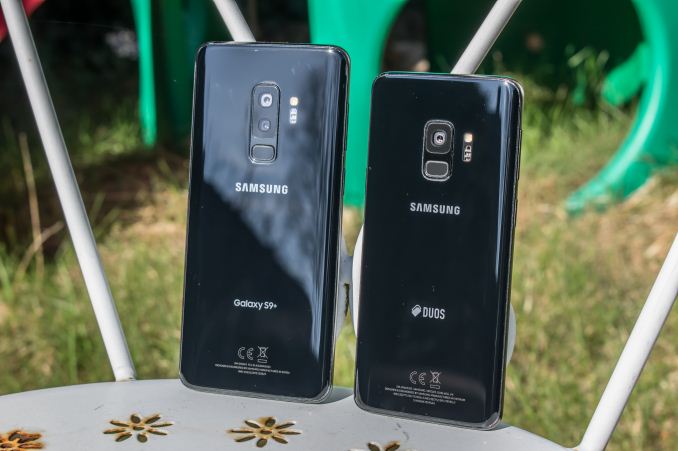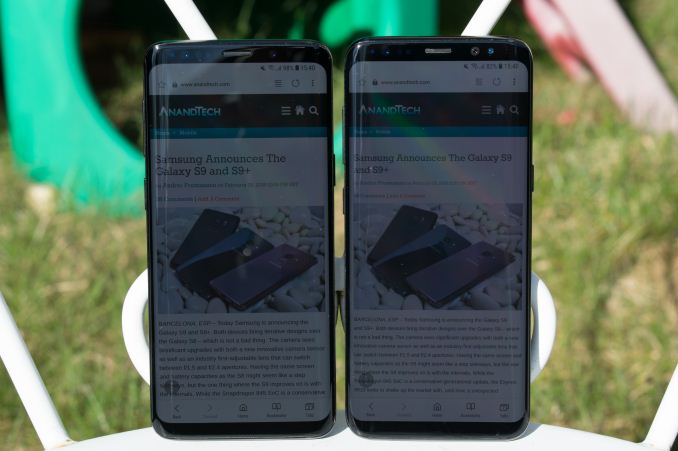The Samsung Galaxy S9 and S9+ Review: Exynos and Snapdragon at 960fps
by Andrei Frumusanu on March 26, 2018 10:00 AM ESTConclusion & End Remarks
The conclusion for the Galaxy S9 is always the toughest part to write as it’s where we have to reconcile all the pros and cons of the device and making a verdict on its value as a product to customers.
In terms of design, the S9 iterates on the S8 and I think that’s definitely a positive until Samsung somehow produces a better design overhaul. The changes we find here aren’t exactly ground-breaking and most people will get used to them very fast. The fingerprint scanner location is among the biggest ergonomics changes and while for me personally it didn’t do much, there’s plenty of people who find it an improvement.
The speaker sound quality of the Galaxy S9 is a massive improvement and this is now by far the best sounding smartphone device. The stereo speakers as well as the audio processing tuning along with the improved main speaker design all just provide a much better experience. I may not have covered this in the introduction, but Samsung’s choice to retain the 3.5mm jack is absolutely the right thing to do. I’ve got very strong feelings about companies’ rationales behind removing the headphone jack and find their reasoning either misguided or outright misleading, and just very anti-consumer choice. Here’s to hoping that Samsung sticks with it in the future, and as absurd as this is that I have to praise them for it, I have to do it to ensure that companies listen.
The screen of the Galaxy S9 holds very little surprises as it has only marginal improvements over the S8. It’s still among one of the best screens on smartphones, and honestly there’s not much more to say.
The camera of the Galaxy S9 for me had some high points and some low points. The high points are that the variable aperture of the S9 has real benefits and direct advantages in picture quality in day-light shots. The S9’s reduced usage of sharpening provided the cleanest pictures among all smartphones and thanks to its improved sensor its effective spatial resolution is actually higher than some higher resolution camera devices. The low-light shots also come with a quality improvement over the S8 – although it will depend on the lightning and scene to notice them at their full effect. Right now the S9 has the best low-light camera.
While the hardware of the S9’s camera definitely deserves praise, the software has notable issues in daylight shots. The Galaxy S9 has a very bad tendency to overexpose and compress the image’s dynamic range. In Pro mode these issues largely go away, but for the Galaxy S9 to offer a better point-and-shoot experience than the S8 or the new iPhones, Samsung needs to rework its camera calibration in Auto mode as right now it can be the odd one out in terms of results.
Finally, the biggest story for the Galaxy S9 is its big contrast in terms of SoC hardware. Ever since we first heard about the Exynos 9810 we had very large expectations and we knew there would be some tangible differences between Exynos and Snapdragon variants. The expectations couldn’t be more shattered than the results we got. While the Snapdragon 845 variant of the Galaxy S9 performed largely as advertised and as we had been told to expect by Qualcomm, the Exynos 9810 failed to live up to its hype in real-world scenarios. Effectively, the Exynos 9810 variant and as evidenced by all the data we collected, is the slower variant of the two. The root cause here has been identified as the extremely conservative scheduler and DVFS mechanisms which essentially nullify any advantage the new M3 cores have in synthetic benchmarks.
In 3D benchmarks, the Exynos 9810 posted very healthy efficiency improvements and even sometimes managed to catch up to last year’s Adreno 540 – something I hadn’t expected. Qualcomm’s new Adreno 630 raises the bar in terms of peak performance, however the promises of increased efficiency have not materialised in the commercial hardware as the performance boost comes at a cost of increased power. Effectively, when looking at sustained workloads, the Snapdragon 845 isn’t any faster than the Snapdragon 835 in its GPU department. Fortunately for Qualcomm, they’re still in the lead and this is not a deal-breaker for the Galaxy S9.
While the performance advantage of the Snapdragon 845 variant over the Exynos 9810 variant is something we could live with, the battery life results of the Exynos is definitely a deal-breaker. I’m not sure of the root cause here and whether it’s something that can be fixed by software, but showcasing such a battery runtime regression over its predecessor is universally something that we can all agree on as not acceptable for a flagship device. Based on our testing, it’s especially in heavy use-cases where this will most evident. The Snapdragon 845 variant performed as expected in the battery life tests.
Finally the recommendation of the Galaxy S9 will be based on which market you are in and which variant you’ll be able to purchase. The Snapdragon 845 variant in the US, China and Japan is a healthy upgrade over its predecessors and I don’t really have much to say against it as a phone, besides the camera exposure issues. Here Samsung iterated and perfected over the S8, and whether the S9 is worth to you as an upgrade is something you’ll need to decide based on its individual parts, because as a package, the Snapdragon S9s don’t disappoint.
For readers in markets with the Exynos variant I need to take a slightly different tone. Make no mistake as I say that the Exynos S9 is by far not a bad phone. If you come from older generation devices you will see significant upgrades, but as a flagship coming at a price premium we expect a no-compromise device, and here is where the Exynos S9 doesn’t tick all boxes. The battery life regression that we measured is the single most concerning aspect of the device. Here buyers will need to consider the device with caution and well-thought out consideration and should maybe apply a wait & see approach over the coming months – for one to see if Samsung resolves the issues via software, and secondly, to await the release of competitor’s new product lines for possible better alternatives.












190 Comments
View All Comments
Icehawk - Friday, April 6, 2018 - link
I don’t think they have an editor or have another one of the guys proofread - it’s always a bit harder to do your own editing/I don’t get the impression that they are the best writers per se. Some of it is the haste in which they have been posting articles recently half finished with multiple updates. I don’t think they have the funding or perhaps management, not sure what happened but AT definitely has been on a downward slide since Anand himself left. Still great in-depth articles and good tech though, I’m not being a hater just honest with my opinion. This is still my first or second stop on my daily tech reading.North01 - Monday, March 26, 2018 - link
> It’s curious to see that both the Galaxy S9’s showcase what seems to be worse sustained performance even though efficiency should have gone up – it’s possible that Samsung decided to limit the S9 to lower sustainable TDPs for cooler devices or longer battery life. We’ll have to verify this theory in another Snapdragon 845 device in the future – the sustained GPU performance might be higher in that case.This is something I'm really curious about.
Robikonobi - Monday, March 26, 2018 - link
What is the difference between auto vs pro auto? I understand that in pro auto you can choose the aperture f1.5 vs f2.4, but why would pro auto produce more acurate exposure as compared to regular auto (as shown in the purple power macro pictures)? In pro auto, the only variable is the difference in aperture, but yet both pro auto shots (in f1.5 and f2.4) produce more accurate exposure than the full auto mode. Any idea why?Andrei Frumusanu - Monday, March 26, 2018 - link
I'm not privy to Samsung's camera algorithms. It is the way it is because it so might be as well the best explanation.lilmoe - Wednesday, March 28, 2018 - link
I found this out by chance, but I'm almost 100% positive that sensor image stacking multi-frame noise reduction are ONLY being utilized in full Auto, because those enhancements are only applied in jpegs. When you switch to pro mode, the app switches all that of because it assumes that RAWs are needed.You're getting a "different" exposure because you're only getting 1 unprocessed image, and a "secondary"/complementary jpeg for fast sharing.
robertkoa - Tuesday, July 3, 2018 - link
Did you try the Pro Mode and just move down minus .5 to .7 on FStop values ?axi6ne8us - Monday, March 26, 2018 - link
Since it has improved stereo speakers and headphone jack, does it include a 32bit DAC with amplifier?robertkoa - Tuesday, July 3, 2018 - link
I have read that it does.And you get premium audio in BOTH versions of CPU.
Remember when you got the premium Wolfson Audio Chip only on Exynos Models previously ?
It's not Wolfson any more but supposedly up to 32bit 196K although not 100% sure- something I read .
Dolby Atmos is great though IMO.
It would be nice on the fantasy S10 Pro in addition to a 4000MAH battery to have a way to digitally input audio at full resolution ...like a Protools Mix etc.
lopri - Monday, March 26, 2018 - link
What an incredible review. It was exhausting to read but in the end it was more than worth it. The degree of thoroughness and precision the review went for is simply hard to believe. The camera section in particular is particularly enlightening in more than one regards. The perfection the review aims for while comparing more than a dozen of phones is never before seen in a smartphone review, and the beautiful scenery the reviewer chose not only makes it easier for readers to compare the results themselves, but also gives a hint of the reviewer's taste, which, I think, adds to the persuasiveness of the reviewer's opinion. I found myself in agreement with the reviewer's assessments as I followed through one scenery at a time. (with the exception of Night Scenic 1, where I thought the S9 did better than the competition) I am also grateful the review did not waste anyone's time nor degraded itself with silly stuff like AR Emoji or make-up picker (?) that other reviewers are seemingly delighted to cover without self-awareness.Lavkesh - Monday, March 26, 2018 - link
While the rest of the so called reviewers are going gaga over the geekbench scores of the Exynos, the real deal, as always, explained better on Anandtech. With such basic performance handicaps, I sometimes wonder whether Samsung should be spoken in, in such high regard in the Android space. Their software is poor, the only thing that they are good in, the hardware, turns out isnt as good as thought and yet no one seems to have problem with these kirf devices being priced almost on a similar level as the iPhone. As always Samdung does not know it any better.